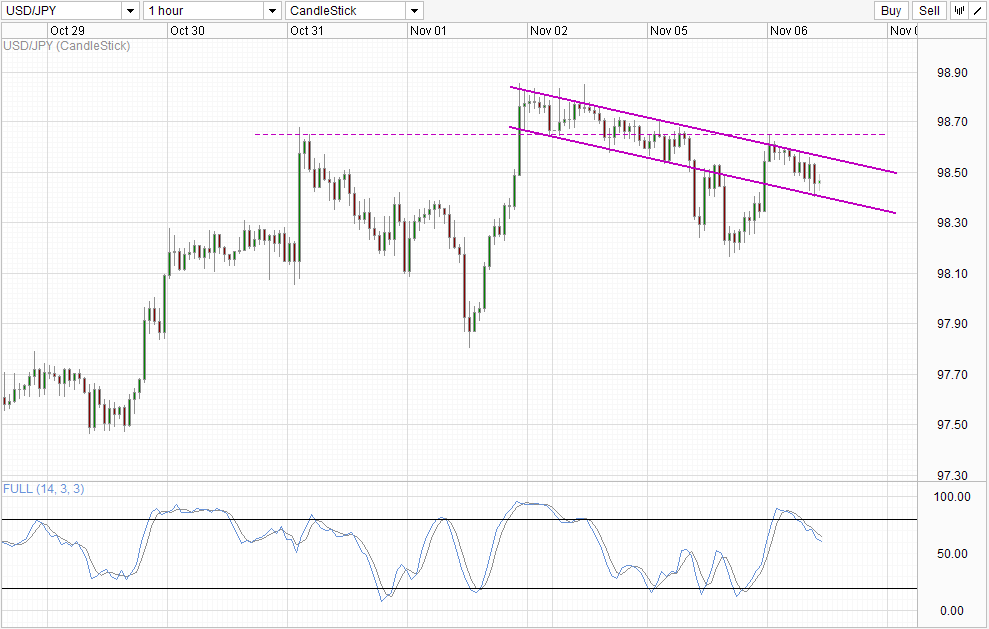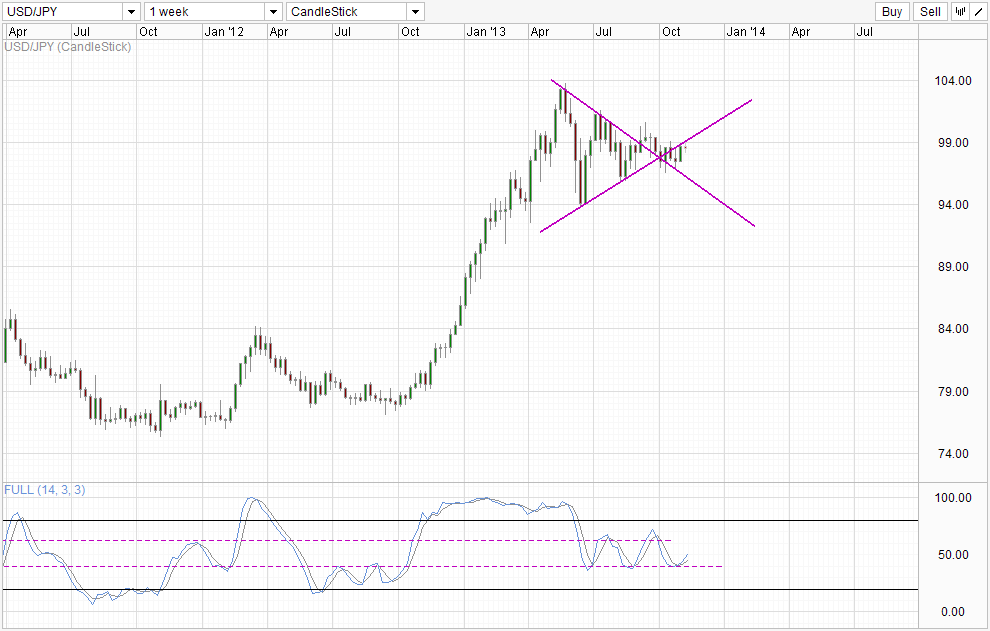USD/JPY has not been directionless since mid April, but price has been moving, with wild swings above and below the ~98.0 axle. This is a reflection of market sentiment that is clearly confused. On one hand, more and more investors/speculators are starting to lose/have lost confidence in BOJ and Abenomic’s ability to artificially weaken Yen further – resulting in capped gains in USD/JPY. On the other, Japanese economic fundamentals are looking brighter than before, suggesting that Abenomics and BOJ stimulus are gaining some traction at least. But then again, overall Japanese economy remains weak, and there are signs that an increase in CPI growth rate has not truly translate into higher economic productivity, and hence there are more that are starting to question the overall strategy of a 2% inflation target.
As a result of this continued confusion, the volatility swings of USD/JPY has steadily declined. 4 weeks Average True Range have declined from a peak of ~400 pips to current ~50 pips, the same levels before the stupendous rally of late 2012. Safe to say, the rally appears to have effectively ended. Right now market is in the reevaluation phase, and waiting for cues from BOJ/Prime Minister Abe.
In this regard, BOJ has been frustrating to say the least. Latest Statement on Monetary Policy on 31st October was a mere 2 sentences affair. There was no mention of the economy, no mention of recent economic events and how they impact Japan, or even if current Yen level and interest rates support the 2% inflation target. This is not helpful and does not provide forward guidance that the market is looking out for right now. Minutes of this meeting was released earlier today, which provided slightly more insight than the Statement. But nonetheless forward direction is lacking. There were usual mentions that the economy is “recovering moderately”, and risk of an uncertain US monetary policy was raised, but there was nothing about what possible responses from BOJ would be. As such, market remains none the wiser, and this lack of volatility in Yen will most likely drag on.
Hourly Chart
From a pure technical perspective, prices are currently under bearish bias trading within a mild descending channel. This is in line with the Stochastic bearish cycle signal that is currently in play. However, a temporary bullish pullback is possible as price has just tagged Channel Bottom which opens up a move towards Channel Top. There is also precedence for Stoch curve to bounce higher from the 60.0 level, hence increasing the likelihood of a bullish push.
Weekly Chart
Weekly Chart show price facing resistance from the ascending trendline, but Stochastic readings are bullish within its own “consolidation band”. However, with price volatility decreasing, the likelihood of prices breaking the rising trendline decreases, hence a bearish move towards the 98.0 axle mentioned previously is favored. Stochastic readings sort of agree, with “support” level around 40.0 potentially thwarting strong bearish momentum, decreasing the likelihood of price going too far below the 98.0 axle.
More Links:
AUD/USD – Key 0.95 Level Now Offering Resistance
EUR/USD – Tries to Hold on to 1.35
GBP/USD – Surges Strongly from Support at 1.59
This article is for general information purposes only. It is not investment advice or a solution to buy or sell securities. Opinions are the authors; not necessarily that of OANDA Corporation or any of its affiliates, subsidiaries, officers or directors. Leveraged trading is high risk and not suitable for all. You could lose all of your deposited funds.





